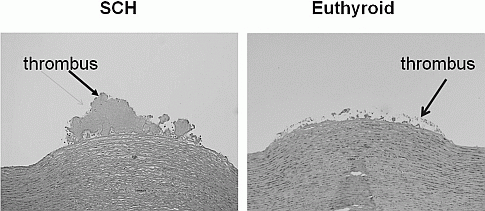SFEBES2012 Poster Presentations Thyroid (52 abstracts)
Higher thrombus burden in patients with subclinical hypothyroidism after non ST elevation acute coronary syndrome
Karthik Balasubramaniam 1 , Girish Viswanathan 1 , Sally Marshall 1 , Asgar Madathil 3 , Juan Badimon 4 , Azfar Zaman 1, & Salman Razvi 3
1Institute of Cellular Medicine, Newcastle University, Newcastle upon Tyne, United Kingdom; 2Cardiology, Newcastle upon Tyne Hospitals NHS foundation trust, Newcastle upon Tyne, United Kingdom; 3Endocrinology, Gateshead Health NHS foundation trust, Gateshead, United Kingdom; 4Cardiology, The Mount Sinai Medical Centre, New York, NY.
Introduction: Subclinical hypothyroidism (SCH) has been associated with increased risk of atherosclerosis and myocardial infarction in a number of cross-sectional and longitudinal studies. As the majority of cardiovascular (CV) events are thromboembolic, we evaluated blood thrombogenicity in patients a few days post acute myocardial infarction with relation to their thyroid status.
Aim: To assess the relationship between thyroid function/status and thrombus formation in patients after non-ST elevation acute coronary syndrome (NSTE-ACS).
Methods: We studied patients one week after troponin positive NSTE-ACS who had been treated with 300 mg loading dose followed by 75 mg maintenance dose of both aspirin and clopidogrel. Patients with known thyroid disease were excluded. All patients underwent ex-vivo Badimon clotting chamber study to assess thrombus burden. TSH, FT4 and FT3 were measured in all individuals. Those with TSH >4.0 mU/L and normal FT4 were classed as having SCH whereas individuals with normal TSH and FT4 were classed as being euthyroid.
Results: Individuals with SCH (n=12) had similar cardiovascular risk factor profile compared to the euthyroid group (n=58) in terms of age, gender, BMI, history of diabetes mellitus, blood pressure and previous vascular disease. The SCH group had a higher thrombus burden as evidenced by the area of the thrombus; mean (SD) 23,608 (10,498) vs 16,661 (10,902) µ2/mm, P=0.02. Furthermore, serum TSH levels (beta co-efficient 0.28) and presence of diabetes (beta co-efficient 0.29) were the only independent and similar predictors of thrombus area in multiple regression analysis (P<0.005).
Conclusion: Individuals with SCH have higher thrombus burden despite optimal recommended secondary prevention therapy following NSTE-ACS. This may explain the higher cardiovascular risk seen in these patients. Future trials need to be performed to assess the effect of individualised anti-thrombotic as well as thyroid hormone replacement therapy to reduce atherothrombotic risk in this population.
Declaration of interest: There is no conflict of interest that could be perceived as prejudicing the impartiality of the research reported.
Funding: No specific grant from any funding agency in the public, commercial or not-for-profit sector.
Thyroid function test & Thrombus area


Modified Mason tri-chrome staining of thrombus in porcine aorta obtained from Badimon chamber.





